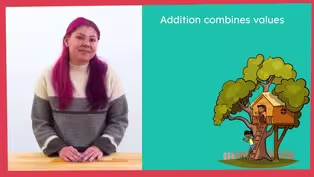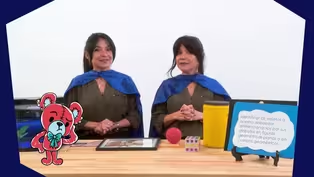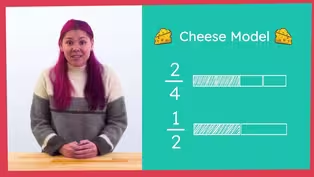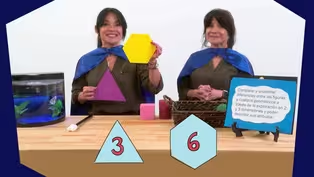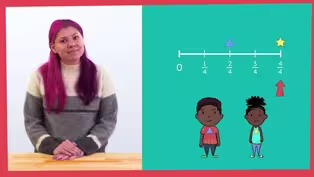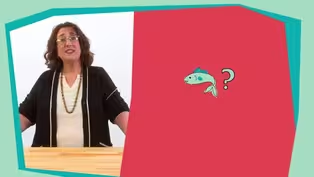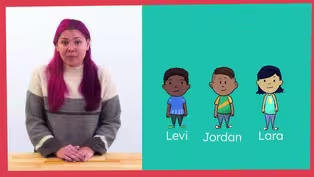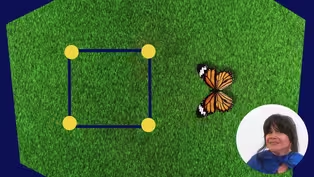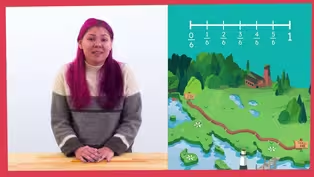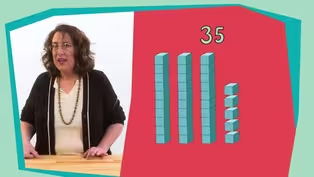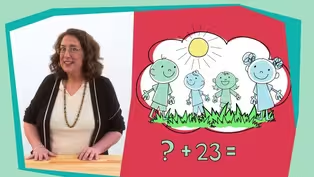
Episode 34 | Math Lessons
4/26/2021 | 28m 46sVideo has Closed Captions
Math lessons for early learners, led by NC teachers.
The first lesson (aimed at 3rd graders) demonstrates fluency with multiplication and division with factors. The second lesson (aimed at PreK-K learners) helps early learners understand the number of objects is the same whether scattered in a line or in a 5 frame. Classroom Connection is your At-Home Learning companion where children love to learn. All lessons are led by NC educators.
Problems playing video? | Closed Captioning Feedback
Problems playing video? | Closed Captioning Feedback
At-Home Learning Presents: Classroom Connection is a local public television program presented by PBS NC

Episode 34 | Math Lessons
4/26/2021 | 28m 46sVideo has Closed Captions
The first lesson (aimed at 3rd graders) demonstrates fluency with multiplication and division with factors. The second lesson (aimed at PreK-K learners) helps early learners understand the number of objects is the same whether scattered in a line or in a 5 frame. Classroom Connection is your At-Home Learning companion where children love to learn. All lessons are led by NC educators.
Problems playing video? | Closed Captioning Feedback
How to Watch At-Home Learning Presents: Classroom Connection
At-Home Learning Presents: Classroom Connection is available to stream on pbs.org and the free PBS App, available on iPhone, Apple TV, Android TV, Android smartphones, Amazon Fire TV, Amazon Fire Tablet, Roku, Samsung Smart TV, and Vizio.
Providing Support for PBS.org
Learn Moreabout PBS online sponsorshipMore from This Collection
Math lessons for early learners, led by NC teachers.
Video has Closed Captions
Math lessons for early learners, led by NC teachers. (28m 46s)
Video has Closed Captions
Math lessons for early learners, led by NC teachers. (28m 46s)
Video has Closed Captions
Math lessons for early learners, led by NC teachers. (28m 46s)
Video has Closed Captions
Math lessons for early learners, led by NC teachers. (28m 46s)
Video has Closed Captions
Math lessons for early learners, led by NC teachers. (28m 46s)
Video has Closed Captions
Math lessons for early learners, led by NC teachers. (28m 46s)
Video has Closed Captions
Math lessons for early learners, led by NC teachers. (28m 46s)
Video has Closed Captions
Math lessons for early learners, led by NC teachers. (28m 46s)
Video has Closed Captions
Math lessons for early learners, led by NC teachers. (28m 45s)
Video has Closed Captions
Math lessons for early learners, led by NC teachers. (28m 46s)
Video has Closed Captions
Math lessons for early learners, led by NC teachers. (28m 45s)
Video has Closed Captions
Math lessons for early learners, led by NC teachers. (28m 46s)
Providing Support for PBS.org
Learn Moreabout PBS online sponsorship[cheerful upbeat music] ♪ - Hey, everyone!
I'm really glad you're here today because I need your help.
I'm trying to write this song but I keep getting stuck!
Here, let me show you.
All right, here it goes.
♪ One, two, three, four ♪ ♪ Put on my shoes and walk out the door ♪ ♪ I said five, six, seven, eight ♪ ♪ The sun is shining and I'm feeling fine ♪ That doesn't rhyme, hold on, hold on, hold on.
♪ Five, six, seven, eight ♪ ♪ The sun is shining and I'm feeling good ♪ No, no, that's not right either [groans].
Now, what's a word that rhymes with eight and means super good?
Wait, hold up.
I think I heard something.
Now, say that again.
Great!
Yes, that's it, that's it!
♪ Five, six, seven, eight ♪ ♪ The sun is shining and I'm feeling great ♪ Wow.
Whew.
Thank goodness you're here or I would have never finished that song.
Looks like I could use some more practice with my reading and my numbers.
You wanna practice too?
Okay, let's do it together.
Starting now.
- Hi, mathematicians.
It's me, Ms. Altman, and it's amazing to see you!
Before we get started, let's take 20 seconds to grab some supplies that we will need for our time together today.
You will need paper and a pencil.
I'm going to go and get mine.
Why don't you go ahead and do the same?
See you in a little bit!
[gentle music] Today we are going to learn a new strategy where we decompose, or break apart, one of the factors in a multiplication equation.
There are two very important math vocabulary words I want you to remember during this lesson.
Those words are factors and product.
Let's take a look at a multiplication problem.
3 times 4.
Factors are the numbers being multiplied to produce a given number.
In this problem, 3 and 4 are the factors.
The product is the result when two factors are multiplied.
In this example, the product is 12.
Sometimes we might have a math problem to solve and we may not immediately know the product.
We can decompose or break apart one of the factors to help us solve the problem.
Let's solve a word problem and I will show you how to decompose a factor.
Are you ready?
Joquan's cat eats four cans of cat food each day.
How many cans will his cat eat in one week?
Let's write an equation to represent this problem.
What are the factors or the numbers being multiplied in this problem?
That's right, 4 and 7 are the factors.
[air whooshes] [happy music] Oh, someone has a question?
How did we get 7?
It's because we need to multiply by the number of days in one week.
And we know that there are seven days in a week.
Multiply the factors, 4 times 7, would give us the product, which is the total number of cans of food that Joquan's cat eats each week.
What's that?
You don't remember your seven facts?
That's totally okay.
This is the perfect opportunity to learn how to decompose or break apart a factor to help solve this problem.
Let's break the factor 7 apart.
Hmm.
I wonder how we should break the factor 7 apart.
Whisper it to me.
[gasps] I heard someone say that 7 is the same value as 4 plus 3.
That's excellent thinking.
We should decompose 4 times 7 into two groups.
4 times 3 and 4 times 4.
Look at how that changes our array.
4 times 7 is the same value as 4 times 3 plus 4 times 4.
Do you recall those facts?
Oh, you do?
Great!
Let's think about the product of each one.
What is the product of 4 times 3?
That's right, 4 times 3 is 12.
Very good.
Okay, how about 4 times 4?
What is the product of 4 times 4?
Correct!
The product of 4 times 4 is 16.
Now we can add both products back together to solve our original problem.
Let's try it out.
12 plus 16 equals 28.
Wow!
Well done!
Let's recap.
Our original problem was 4 times 7.
Some of our mathematicians did not remember their seven multiplication facts.
So we decomposed or broke apart the factor 7 into 4 and 3.
4 times 7 was decomposed into two groups.
4 times 3 equals 12 and 4 times 4 equals 16.
Then we added both products together.
12 plus 16 equals 28.
That's our answer.
So 4 times 7 equals 28.
By decomposing the factor 7 into 4 and 3, we were able to solve the problem efficiently and accurately.
[air whooshes] What's that?
Oh, your thinking is absolutely correct.
You can break the factor 7 apart in different ways.
There are many ways to decompose numbers.
Let's think about that as we solve another problem.
Are you ready?
Let's do this.
Let's use our strategy of decomposing a factor to solve 9 times 6.
[bright music] Which factor should we decompose?
I heard someone say that we should decompose the factor 6.
We could have decomposed either factor, the 6 or the 9, but since one of the mathematicians suggested 6, let's decompose that factor.
How shall we decompose the factor 6?
Yes, we can decompose 6 into 3 and 3.
Very good.
If we decomposed the factor 6 into 3 plus 3, that means we can rewrite our problem 9 times 6 as 9 times 3 plus 9 times 3.
Now we have two groups of 9 times 3.
Decomposing the factor of 6 makes the problem easier to solve.
So let's solve it!
What is 9 times 3?
[gentle guitar music] Let's use an array to represent the multiplication for each group of 9 times 3.
What is the product of 9 times 3?
That's right, 27.
Because we have two groups of 9 times 3, we have to represent that twice.
Now we can add the products together.
27 plus 27 equals?
54!
We decomposed 9 times 6 into 9 times 3 plus 9 times 3 to find the product of 54.
Awesome!
Let's decompose 9 times 6 another way by decomposing the 9.
[clapping] This is so much fun!
What are the different ways that we can break apart the factor 9?
I'll give you some time to think about that.
Turn and talk to a friend or trusted adult.
What are all the different ways that we can decompose the factor 9?
You are doing an excellent job, mathematicians.
We can break apart the 9 factor into 8 plus 1, 7 plus 2, 6 plus 3, 4 plus 5, and so on.
Wow, that's a lot of ways to break apart the factor of 9.
Which one should we pick?
That is, which way should we break apart the 9 factor so we can solve 9 times 6?
Oh, you want to decompose the 9 into 4 and 5?
That's a great idea!
We can do that.
Let's rewrite 9 times 6 as 5 times 6 plus 4 times 6.
Let's solve the product for each problem.
What is the product of 4 times 6?
That's right, 24.
Now, what is the product of 5 times 6?
You've got it!
5 times 6 equals 30.
Don't forget, we have to add the two products together to solve the problem.
24 plus 30 equals 54.
So 9 times 6 equals 54.
Decomposing the factor of 9 into 5 plus 4 helped us think through this problem.
Let's take another look using an array to solve 9 times 6.
To solve 9 times 6, we broke the factor 9 apart into 4 and 5 or 4 times 6 plus 5 times 6.
4 times 6 equals 24.
5 times 6 equals 30.
So 9 times 6 equals 54.
Did you enjoy learning this strategy?
Great!
After this video, you should continue trying out this strategy with all the multiplication facts.
You can use an array to check your thinking.
Today we learned a strategy where we decomposed or broke apart a factor in a multiplication problem.
Decomposing factors is a multiplication strategy that allows you to break one of the factors apart and add them together to solve the original problem.
Some mathematicians like this strategy because it allows them to decompose a factor into numbers they are more comfortable with as they become more fluent in multiplying within 100.
Thanks for joining me.
This was so much fun and I hope you have fun too.
Bye, mathematicians!
Until next time!
[gentle chime music] - Hey, everyone.
I was just thinking about what it means to be, what it means to be me.
And maybe you think about this too.
I think I'm pretty cool.
I've got great style, and I'm kind and generous with others.
I love learning.
But sometimes I see other people and I start to doubt myself.
I start to think that maybe I'm not good enough.
Sometimes I look all around and I don't see anyone that looks like me or sounds like me or dresses like me.
And I start to wonder if I'm okay just the way I am.
[sighs] Maybe I need to do more to fit in with those people I see.
Well, check this out.
You are always enough.
The truth is, there is nobody else in this world like you.
How cool is that?
There are always going to be people who look different or sound different, but no matter what, you are enough just as you are.
And you matter!
I think that to myself when I'm feeling like I'm not good enough.
I am enough.
Y'all say it with me.
I am enough.
It helps, I'm telling you.
All right, let's keep this train moving.
We got lots more to do today.
- My name's Dave Kilbride.
I play first violin in the North Carolina Symphony String Quartet.
String quartet is made up of two violins, a viola, and a cello.
Maurice Ravel wrote a quartet that uses sound effects like pizzicato and trills and tremolo.
For example, at the start of the second movement, all four of us play pizzicato or plucked.
It is a really fun passage for us.
Take a listen.
[gentle orchestral music] The next thing that Ravel asks us to do is he has the first violin play a trill, which is shortened from the Italian term trillo.
It just means alternating between two notes, very rapidly.
But he has me do it three different ways, low, [fast violin music] middle, [fast violin music] and high.
[fast violin music] Anton?
- Hi, kids!
I'm Anton, originally from Siberia.
It is very beautiful in Siberia in the summer, but very, very cold in the winter.
So cold that your teeth will chatter and your arms would shiver.
Imagine playing the violin while you're shivering and you get a stroke called tremolo, which in Italian means tremble.
[tense violin music] - As we play this second movement of Ravel's string quartet, you'll see and hear pizzicato, trills, and tremolo take center stage, which makes this piece so unique.
[dramatic classical music] - That was so cool.
Did you know about all that kind of music?
I am so glad we got to see that.
[chill music] - Hello, super learners.
Ms. M here.
I'm so glad that you are here today.
Are you ready for another math adventure?
Well, let's get started with a song.
♪ Hello, super learners ♪ ♪ How are you ♪ ♪ Hello, super learners ♪ ♪ How are you ♪ ♪ I'm so glad you're here today ♪ ♪ And I hope you feel the same ♪ ♪ Hello, super learners ♪ ♪ How are you ♪ I feel amazing today, super learners, and I hope you do too.
Now it's time for our math power warmups, counting up to 20.
Are you ready?
'Cause here we go!
♪ One, two, three, four ♪ ♪ Five, six, seven ♪ ♪ Eight, nine, 10 ♪ ♪ 11, 12 ♪ ♪ 13, 14, 15 ♪ ♪ 16, 17, 18 ♪ ♪ 19, 20 ♪ ♪ That was fun ♪ Let's count to 20 again.
Are you ready to snap count with me?
We're gonna snap count right up to 20.
Let's go!
One [snaps], two [snaps], three [snapping], four [snaps], five [snaps], six [snapping], seven [snaps], eight [snaps], nine [snapping], 10 [snaps], let's keep going!
11 [snaps], 12 [snaps], 13 [snapping], 14 [snaps], 15 [snaps], 16 [snapping], 17 [snaps], 18 [snaps], 19 [snapping], 20, yes [snaps], super learners are the best.
I'm getting warmed up and I hope you are too!
One more time counting to 20, but this time let's do it in Spanish.
[speaking in Spanish] Very good, super learners.
Now it's time to review our colors.
Let's say them in English and Spanish.
[speaks in Spanish] Red, [speaks in Spanish] orange, [speaks in Spanish] yellow, [speaks in Spanish] green, [speaks in Spanish] blue, [speaks in Spanish] purple, [speaks in Spanish] brown, [speaks in Spanish] black, [speaks in Spanish] white, and [speaks in Spanish] gray.
Look for these colors in the world today.
And now for our last math power warmup, the shape game!
You will see a shape and then you'll say its name in English or Spanish: [speaks in Spanish] square, [speaks in Spanish] circle, [speaks in Spanish] triangle, [speaks in Spanish] rectangle, [speaks in Spanish] rhombus, [speaks in Spanish] trapezoid, [speaks in Spanish] hexagon, [speaks in Spanish] cube, [speaks in Spanish] cone, [speaks in Spanish] cylinder, [speaks in Spanish] sphere.
Math-tastic!
[air whooshes] We have finished all our math warmups, so now it's time for... [hands slapping] [gasps] our math mission of the day!
Come on, let's check with Sparkles the Fish to see what our mission is today.
[soft classical music] Thank you, Sparkles.
Let's read!
There it is.
Dear super learners, your mission today is to count the numbers of objects in a variety of ways.
Hmm.
Super learners, I know we can do this mission.
Cape's on!
And you know it.
Math power up!
Let's go!
Oh, look at this.
I have some pompoms here.
I'm gonna put them in a nice row.
[humming] Maybe a few more.
Nice.
Hmm, this must be our first task.
Let's count them.
We know what to do.
One, two, three, four, five, six, seven, eight.
Nice counting, super learners.
There are eight pompoms here.
Hmm.
It looks like there are some more in this bowl.
Hmm.
I wonder what would happen if we added another pompom to our line.
What is the next number after eight, super learners?
Nine, yes!
If we add one more to our number line, we will have nine.
Let's do it.
Nine.
Hmm.
There are some more pompoms in the bowl.
If we keep adding to our number line, I know we can get all of our pompoms on the table.
Oh.
Wait.
Did you hear that sound?
I think that was my doorbell ringing.
Hold on, super learners.
I'll be right back.
Keep an eye on these pompoms, okay?
I'll be right back.
[mischievous music] [electronic beeping] Oh no, super learners.
What happened?
[gentle guitar music] The Math Burglar.
Ah, the Math Burglar has spilled all of our pompoms out of the bowl.
How can we count them when they're all over the place?
[gasps] Oh, that's right!
That's a great suggestion.
Let's pick them up one at a time and add them to our number line.
We can still do this, super learners.
Ready?
Math power up!
We have nine in this line.
Okay.
So one more is 10.
One more than that is 11.
Then one more than that is 12.
One more than 12 is 13.
One more than 13 is 14.
One more than 14 is 15.
One more than 15 is 16.
One more than 16 is 17.
One more than 17 is 18.
One more than 18 is 19.
And one more than 19 is 20!
One, two, three, four, five, six, seven, eight, nine, 10, 11, 12, 13, 14, 15, 16, 17, 18, 19, 20.
Amazing job, super learners.
We counted the pompoms and beat the Math Burglar's challenge.
I need a math movement break.
How about you?
Great!
Bounce with me as we count to 20.
Here we go.
One, two, three, four, five, six, seven, eight, nine, 10, 11, 12, 13, 14, 15, 16, 17, 18, 19, 20.
Super bouncing, super learners.
Now look up at the screen.
Look at this math tool.
It is called a 5 frame.
It is a tool that can help us quickly count objects.
If the 5 frame is full, we know we have five objects.
Anything more than five will not fit in the 5 frame, but we can count them too by starting our count at five and then adding to our count one at a time, just like we did earlier.
Let's try it.
[air whooshes] You see those pompoms up there again.
Let's see if there's enough to fill the 5 frame.
We will place one pompom in each square.
One, two, three, four, five.
Yes, there are at least five.
We know this 'cause the 5 frame is full.
We have a few leftover.
Let's use another 5 frame to help us count these.
Keep looking!
Okay, this one group filled a 5 frame so there are pompoms here.
Let's count on from five using this other 5 frame.
So we will start with five, then six and seven.
Let's try it.
Five, six, seven.
We have seven pompoms here.
Great job, super learners.
We used a new math tool called a 5 frame to help us count.
Now we have counted objects in a variety of different ways.
Let's check back with Sparkles the Fish to see how we are doing.
[upbeat music] Mission complete!
Hooray!
Amazing job, super learners.
Congratulations!
You used your math powers and completed the mission.
Now, what is it time to do?
Let's review!
Today we counted objects, adding one more at a time in a line.
We also learned about a math tool called the 5 frame that can help us count objects by counting on starting from five.
Practice your counting today, super learners.
Count different things around you.
You can share your math power by showing it to someone.
Thank you, learners, for going on a math mission with me today.
Sparkles thanks you too.
Remember, super learners, you have the power to be super at math.
Adios!
Bye!
Math power out!
- Well, that's all the time we have for today.
I can't wait to see you next time.
In the meantime, be kind to each other.
Wishing you peace, love, and learning.
[cheerful upbeat music] ♪


- Home and How To

Hit the road in a classic car for a tour through Great Britain with two antiques experts.












Support for PBS provided by:
At-Home Learning Presents: Classroom Connection is a local public television program presented by PBS NC
